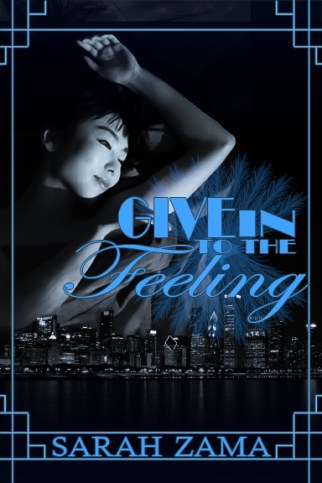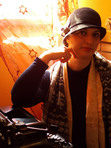Sarah Zama's Blog, page 55
April 2, 2017
Berlin (1940s Film Noir – #AtoZChallenge)
 While Hollywood was the hotbed of filmmaking, especially in the 1920s and 1930s (when there was the absolute major output of featured film in the history of the American film industry), on the other side of the ocean Berlin and Germany established themselves as the centre of experimental cinema.
While Hollywood was the hotbed of filmmaking, especially in the 1920s and 1930s (when there was the absolute major output of featured film in the history of the American film industry), on the other side of the ocean Berlin and Germany established themselves as the centre of experimental cinema.
Although the German cinema started at the very end of the 1800s, it really exploded after WWI. Because it was especially prominent between 1920 (when The Cabinet of Dr. Caligaris was released) and the rise of the Nazis to power (1933), which is also the span of the Weimar Republic, this is also known as Weimar Cinema.
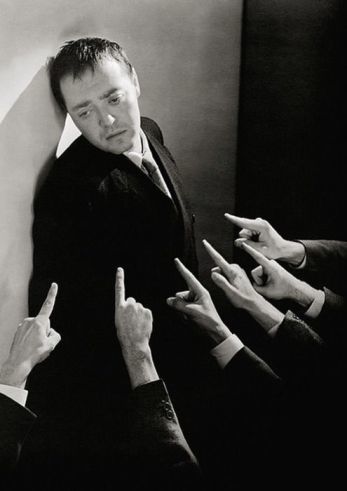
M (1931) by Fritz Lang
The Weimar Republic was a mind-blowing – if ill-fated – social and political experiment. It manifested an unprecedented freedom of expression for many minorities and for women, it dominated in the arts and the sciences, but it was also plagued by political and economic instability. Among these were the huge war reparations Germany was supposed to pay (which in 1923 led to the hyperinfaction) and the rise of a particularly strong totalitarian party destined to take in its hand the fate of the nation… and not just.
The artistic vitality was particularly evident in the film industry, which, if on the one hand expressed a romantic, even fantastic vain, on the other explored the essence of modern life. This more modern vein of German cinema explored the growth of cities, postwar social differences, the rise of the European fascism, technological progress and the shift in sexual roles. Avant garde at its highest.
But it also had to cope with the lack of funds. Unable to afford Hollywood’s huge sets, lavish customs and expensive props, German filmmakers had to find alternative ways to convey atmosphere, mood and emotions. They found their language in Expressionism, which born before the war, found its highest moment in the interwar years and it was a way to suggest what couldn’t (or wouldn’t) be openly said.
In the 1920s in Germany arose a national cinema of international influence #AtoZChallenge
Click To Tweet
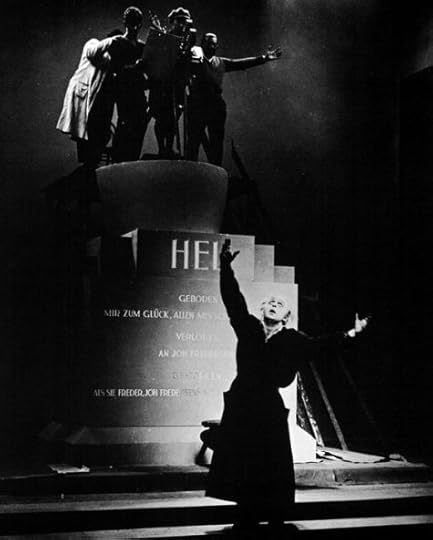
On the set of Metropolis
Weimar cinema sought to address contemporary issues and its themes were a lot darker than Hollywood’s: crime, immorality, social decay and the destructive power of money and technology. Born in the aftermath of WWI, which had left the German people physically and psychologically wounded and the country in a dire economic situation, these films depicted a decadent nightlife, a previously unseen eroticism and unfettered sexuality – particularly in women – whose sense of freedom was nonetheless undercut by a vein of hopelessness just below the surface. Unrequited and thwarted love, uncontrollable criminal activity and the clash between the classes and the generations were foremost film material. The idea of the urban environment simultaneously threatening and enticing; the figure of the immature man-child fatally incapable of taking control; the emasculated male, the fallen woman were all fair games.
The language of the Expressionist style, characterised by deeply shadowed lighting, distorted perspectives and intentionally artificial sets, was perfect for this message. It wasn’t a direct relay of reality, rather it was a filter, a way to express on screen the messy feelings of a vital but problematic time. Sex morality, depression, veterans ghoulishly mangled by war, the loss of innocence and the complete rejection of the past were the issues the German people dealt with in the postwar period. Films like M explore ethics in a very complex, layered way. Films like Metropolis expose the injustice embedded in a society that accepts that not all people are equal. It was only a matter of time before this kind of cinema attracted the wrong kind of attention from the Nazi government.
Many directors and writers who first made their groundbreaking films in Germany were forced to flee when the Nazi Party rose to power. A great number of them poured to Hollywood, where they could find a job they knew how to do.
And soon, Hollywood realised these German cinematographers who had come from the other side of the world possessed the language to express the rising anxiety American society was experiencing.
——————————————————————————-
FILMS CITED
The Cabinet of Dr Caligaris (1921) by Robert Wiene
At a carnival in Germany, Francis (Friedrich Feher) and his friend Alan (Rudolf Lettinger) encounter the crazed Dr. Caligari (Werner Krauss). The men see Caligari showing off his somnambulist, Cesare (Conrad Veidt), a hypnotized man who the doctor claims can see into the future. Shockingly, Cesare then predicts Alan’s death, and by morning his chilling prophecy has come true — making Cesare the prime suspect. However, is Cesare guilty, or is the doctor controlling him?
Metropolis (1927) by Fritz Lang
This influential German science-fiction film presents a highly stylized futuristic city where a beautiful and cultured utopia exists above a bleak underworld populated by mistreated workers. When the privileged youth Freder (Gustav Fröhlich) discovers the grim scene under the city, he becomes intent on helping the workers. He befriends the rebellious teacher Maria (Brigitte Helm), but this puts him at odds with his authoritative father (Google synospis)
M (1931) by Fritz Lang
Hans Beckert (Peter Lorre), a serial killer who preys on children, becomes the focus of a massive Berlin police manhunt. Beckert’s heinous crimes are so repellant and disruptive to city life that he is even targeted by others in the seedy underworld network. With both cops and criminals in pursuit, the murderer soon realizes that people are on his trail, sending him into a tense, panicked attempt to escape justice. But when he is finally put to trial, his defence poses unexpected ethic questions.
——————————————————————————-
READ MORE ABOUT IT
The Modernism Lab at Yale University – German Cinema Between 1920 and 1930
Alpha History – Weimar Cinema
Harvard Film Archive – Decadent Shadows: the Cinema of Weimar Germany
Lacma Unfraimed – Haunted Screens: German Cinema in the 1920s
Mubi – German Expressionism: the world of light and shadow
Smashwords | Barnes&Nobles | Kobo | iBookStore
And many other stores
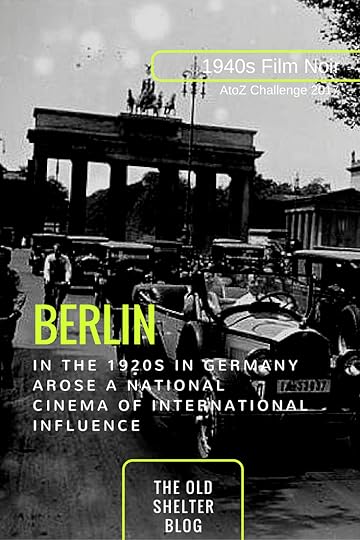
The post Berlin (1940s Film Noir – #AtoZChallenge) appeared first on The Old Shelter.
March 31, 2017
America (1940s Film Noir – #AtoZChallenge)
 When we talk film noir, we’re talking about a very specific place at a very specific time: The United States in the 1940s.
When we talk film noir, we’re talking about a very specific place at a very specific time: The United States in the 1940s.
At this time in America, anxiety was rising and Hollywood caught and expressed it, especially through a series of crime thrillers that were later named ‘noir’.
Most critic agree that the first film noir is The Maltese Falcon (1941) from the novel by Dashiell Hammett and featuring a favourite star of the film noir, Humphrey Bogart. It looked like a promising start, and still there followed three years of nothing on the film noir side. Why?
The entry of the US into WWII set in motion a strong process of cultural mobilisation. Official propaganda agencies (like the Office of War Information) required that all cultural discourses converged on a message of unity, purpose and struggle that would displace any division caused by class, race or sexual inequality.
Hollywood response was a series of film where the male hero is part of a team (often a war squad) which function as a microcosm of American society. Only by being united and working together, the team may achieve the ultimate goal.
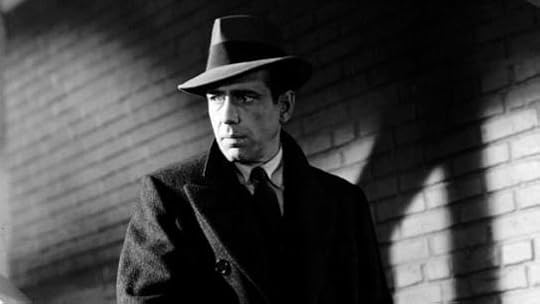
Humphrey Bogart (The Maltese Falcon)
But while this was happening on the screen, huge changes were underway in real society. The mass drafting of men into the armed forces left many jobs vacant. As part of their ‘patriotic duty’, women were strongly encouraged to take up those jobs, which they did in large numbers. This cause a massive, rapid redefinitions of their social role: not just wives and mothers anymore, they took up and successfully covered positions previously only covered by men.
When soldiers came back from the war, they found that America had dramatically changed during their absence and they found it hard to be integrated into it. Women shifting position in particular caused a temporary confusion about traditional sexual roles and sexual identity for both men and women.
Film noir was the visualisation of American anxiety in the 1940s #FilmNoir #AtoZChallenge
Click To Tweet
As a cultural institution, Hollywood sought to address these changes, but was hindered by the wartime cultural mobilisation and its logic of unity. This was in stark contrast with the new reality of women who sought economic and social advancement, thus upturning traditional sexual roles. So, during the war year this change, that was actually happening, remained under the radar of entertainment cinema.
But in 1944 the climate changed drastically. With victory in sight, ‘wartime’ issues started to give way to ‘postwar’ issues and the ‘problem’ of working women and the social insecurity they cause came to the fore. Themes that had been glossed over during the war in the name of a necessary unity exploded on the screen.
Film noir picked up those anxieties, uncertainties and fears and with its damage male hero and its dangerous and ambitious femme fatale, it became one of the most popular form of entertainments of the 1940s.
——————————————————————————-
FILMS CITED
The Maltese Falcon (1941) directed by John Huston
Detective Sam Spade (Humphrey Bogart) gets more than he bargained for when he takes a case brought to him by a beautiful but secretive woman (Mary Astor). As soon as Miss Wonderly shows up, trouble follows as Sam’s partner is murdered and Sam is accosted by a man (Peter Lorre) demanding he locate a valuable statuette. Sam, entangled in a dangerous web of crime and intrigue, soon realizes he must find the one thing they all seem to want: the bejeweled Maltese falcon. (Google synopsis)
——————————————————————————-
READ MORE ABOUT IT
Krutnik, Frank, In a Lonely Street. Routledge, 1991, London/NYC
Smashwords | Barnes&Nobles | Kobo | iBookStore
And many other stores
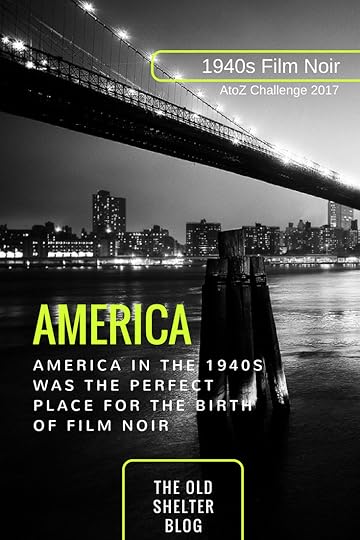
The post America (1940s Film Noir – #AtoZChallenge) appeared first on The Old Shelter.
March 30, 2017
Thursday Quotables – Tan
‘So long ago… a different world, Liam… How the fuck are ye, and what the fuck are ye doin’ in that get up?’ his voice took on an angry edge.
Liam leaned the rifle against the wall and sat on the bed, suddenly ashamed.
‘I’ve been asking myself the same question a lot these days. I’m sorry I ever got involved with this shower. How are you – apart from hidin’ out in attics, I mean?’
‘I heard you were back, but I didn’t believe what they were sayin’ – you, a Tan…?’
‘It’s a long story. I was in a bad fix in England and thought I’d found a way out.’
‘Well ye got that wrong.’
‘I know. I’m just tryin’ to figure a way out of it all.’
Frank picked up the Lee Enfield and studied it, a professional admiring another man’s tool. ‘What’s to figure? Just go – join me and the boys… put this thing to proper use,’ he said, shaking the rifle. ‘We’re fightin’ for our lives. We need good men, Liam; and you’re one of the best I know, in or out of that stupid fuckin’ uniform. Typical of the Brits, can’t even get a jacket and trousers to match and they still expect to rule this country. The arrogance…’
Liam smiled. ‘Still the same Francie…’
‘That’s Captain Cleary to you, boy, I’ve been elevated,’ he grinned. ‘Look, you can’t stay with that lot, it’s all wrong… fight for your country not these thugs. You’re needed… mind you, it’d take some convincin’ the lads you weren’t some manner of spy, soft head that ye are, but I’d bring them round. What d’ye say?’ the grin was gone and the eyes were deadly serious.
Tan by David Lawlor is one of those rare novels that jumps the more frequented time of the Easter Rising and delves into the painful time that follows in Irish history: the War of Indipendence. As all wars fought at home, this is a time that tasted people in more than one way. A man or a woman had to be really certain of their stance to go through such times.
David Lawlor clearly knows these time very well. His depiction not just of the events, but of the feelings of people and their reasons are so naturally entwined with the story that it’s almost a given. And some of the events described are so detailed and personalthat it almost suggests me they come from true oral history. In spite of the very sparse style, this is a story that involves because of the sheer power of its subject matter.
It is a very ‘male’ story, and I actually appreciated this. In a time where writing strong female characters seem to be the thing to do (and there are a few strong female characters in this story, don’t be misled!), I appreciate the choice to go in a different direction.
It’s a ‘male’ story not just because most of the characters are men doing men’s stuff (namely, war), but because of the kind and quality of the relationships depicted: father and son, brotherly love and friendship and betrayal, virile camaraderie and rivalry. But it also touches more universal themes of love and betrayal, of alienation and belonging.
It’s a good story. Read it!
—————————————————————————————————————-
 This post is part of the Ireland Reading Month organised by 746 Books and The Fluff Is Raging blogs.
This post is part of the Ireland Reading Month organised by 746 Books and The Fluff Is Raging blogs.
“Last year we hosted a whopping 130 posts on all things relating to Irish culture. Books, food, travel, movies, theatre and favourite bookshops – your enthusiasm was boundless and so was your reading.
So this year we hope to be bigger and better.
To celebrate the wealth and breadth and general awesomeness of Irish cultural life, 746 Books and Raging Fluff are co-hosting a month long celebration of all things Irish.”
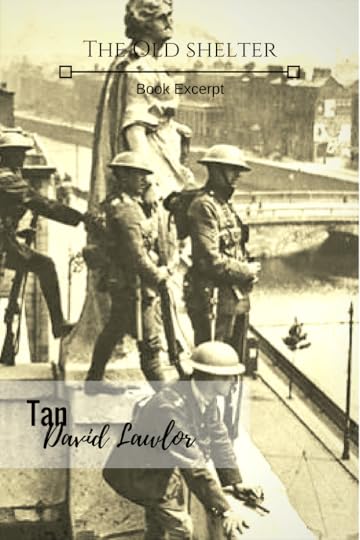
The post Thursday Quotables – Tan appeared first on The Old Shelter.
March 27, 2017
Home (James Joyce)
James Joyce
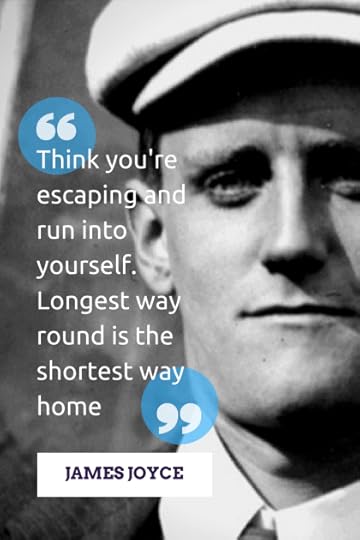
——————————————————————————————————————-
 This post is part of the Ireland Reading Month organised by 746 Books and The Fluff Is Raging blogs.
This post is part of the Ireland Reading Month organised by 746 Books and The Fluff Is Raging blogs.
“Last year we hosted a whopping 130 posts on all things relating to Irish culture. Books, food, travel, movies, theatre and favourite bookshops – your enthusiasm was boundless and so was your reading.
So this year we hope to be bigger and better.
To celebrate the wealth and breadth and general awesomeness of Irish cultural life, 746 Books and Raging Fluff are co-hosting a month long celebration of all things Irish.”
The post Home (James Joyce) appeared first on The Old Shelter.
March 25, 2017
60th Anniversary of the Treaties of Rome
On 25th March 1957, two treaties were signed in Rome that gave birth to the European Economic Community (EEC) and to European Atomic Energy Community (Euratom): the Treaties of Rome. The signatories of the historic agreement were Christian Pineau on behalf of France, Joseph Luns from the Netherlands, Paul Henri Spaak from Belgium, Joseph Bech from Luxemburg, Antonio Segni from Italy and Konrad Adenauer from the Federal Republic of Germany. The Treaties were ratified by National Parliaments over the following months and came into force on 1st January 1958.
You have come here to honour the free political union of Europe with your signs. The aim is to guide the peoples of this old Europe to union and harmany. May God illuminate your minds and warm up your hearts. This the the vow of Rome.
– Antonio Segni
The post 60th Anniversary of the Treaties of Rome appeared first on The Old Shelter.
March 19, 2017
AtoZ Challenge Theme Reveal Blogfest Day 2017
And so here we go again! This is the third year I attempt the AtoZ Challenge and hope everything goes as it should!
For those who don’t know, the AtoZ Challenge is a blogging challenge taking place in April where participants blog every day except Sunday, moving along the alphabet. On the first of April, we’ll blog about something ‘A’, on the second about something ‘B’ and so on.
If someone wants, these posts can be linked not just by the alphabet, but also by a theme.
I learned about the challenge soon after I created my blog in 2014, too late to participate, but I took part in both 2015 and 2016 and had a ton of fun. Sure there will be people telling you it is stressing. It does take time and effort, I won’t deny it, but I’ve met so many wonderful people and blogs during the challenge that a bit of work really isn’t all that bothersome.
My themes so far were:
2015 – The Roaring Twenties
2016 – Jazz Age Jazz: early jazz as a social phenomenon
For this year’s challenge I’ve decided to step away from my usual 1920s subjects and do something a bit darker.
Enter my theme!
1940s FILM NOIR
The ‘Femme Fatale’ and the ‘Damage Hero’ fight on the ring of postwar America
1940s FILM NOIR The ‘Femme Fatale’ and the ‘Damage Hero’ fight on the ring of postwar America…
Click To Tweet
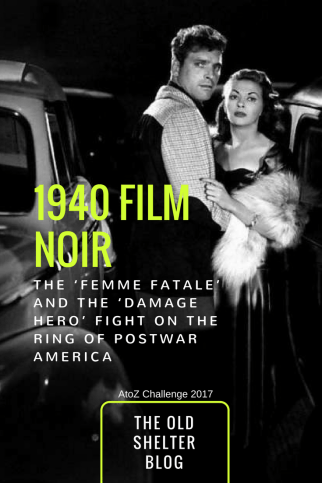 Everyone knows a film noir when they see it, right? It is something so characteristic and so ingrain in our aesthetic sense that we don’t even think about it.
Everyone knows a film noir when they see it, right? It is something so characteristic and so ingrain in our aesthetic sense that we don’t even think about it.
Still, film noir is one of the most slippery, blurry, ethereal subjects of the film industry. Nobody can even agree on what exactly film noir is. And to make things worse, no director, in the classic time of film noir, ever decided to make a ‘film noir’ since the concept didn’t even exist back then.
The term film noir was coined in France, after WWII, when many Hollywood films finally arrived in Europe. French critics noticed a new trend in the American crime films: they were grittier, dirtier, more disillusioned and generally more pessimistic than Hollywood films ever used to be. These critics noted a trend that seemed to have spontaneously emerged in Hollywood during the war and termed it ‘film noir’ (literary ‘black film’), creating a concept that previously hadn’t existed.
If film noir was never a goal or a guide for any of the filmmakers who made those films, its inspiration did arise from a very specific historical and social situation engendered by the war. Film noir tells of anxiety, of uncertainties, of shifting roles and lost morals, of people who can’t cope with society and often act against it, because society can’t offer what they need.
The world of film noir is a world marked by a World War that has destroyed everything, before anything is reconstructed. It’s a world of immingrants, scant means, personal resourcefulness and dark lances.
In these films, the world of men damaged by the war is in stark contrast with the world of women that the war has empowered. The film noir femme fatale is a powerful, wilful woman who knows exactly what she wants and how to get it, a fascinating but unsolvable problem for a hero that is instead confused and wounded.
And here, in the unresolved ground of the unmatchable differences between men and women is where the anxiety of an entire era emerges. To the damaged hero of film noirs, the femme fatale is the unknown, inscrutable future.
Welcome to my AtoZ Challenge. I hope you’ll enjoy it.
Smashwords | Barnes&Nobles | Kobo | iBookStore
And many other stores
The post AtoZ Challenge Theme Reveal Blogfest Day 2017 appeared first on The Old Shelter.
March 16, 2017
Thursday Quotables – An Encounter
In the morning I was first-comer to the bridge as I lived nearest. I hid my books in the long grass near the ashpit at the end of the garden where nobody ever came and hurried along the canal bank. It was a mild sunny morning in the first week of June. I sat up on the coping of the bridge admiring my frail canvas shoes which I had diligently pipeclayed overnight and watching the docile horses pulling a tramload of business people up the hill. All the branches of the tall trees which lined the mall were gay with little light green leaves and the sunlight slanted through them on to the water. The granite stone of the bridge was beginning to be warm and I began to pat it with my hands in time to an air in my head. I was very happy.
Isn’t James Joyce a pure joy to read? I have a confession: for a long time, I refused to read Joyce because I was convinced that it is too difficult to read for me. Well, it isn’t easy, I’ll give you that. The first story in Dubliners, The Sisters, shocked me because I came to the end and I didn’t understand anything! Then I made some research and I slowly started to understand the story behind the story. And again I was shocked by the mere power of this author’s art.
I was right to worry about my ability to understand such a complex author, the subtext is extremely rich, but now that I’ve tried, I know it is well worth the job.
Something you don’t need any preparation for is the beauty of Joyce’s prose. It is rich, and smooth, and vivid, and it touches you and you feel like you’re inside the story. And there’s a sound to it, a music, almost. There’s a colour and a texture. You don’t just read it, you experience it.
I’m very happy I’ve finally decided to take up Dubliners.
—————————————————————————————————————-
 This post is part of the Ireland Reading Month organised by 746 Books and The Fluff Is Raging blogs.
This post is part of the Ireland Reading Month organised by 746 Books and The Fluff Is Raging blogs.
“Last year we hosted a whopping 130 posts on all things relating to Irish culture. Books, food, travel, movies, theatre and favourite bookshops – your enthusiasm was boundless and so was your reading.
So this year we hope to be bigger and better.
To celebrate the wealth and breadth and general awesomeness of Irish cultural life, 746 Books and Raging Fluff are co-hosting a month long celebration of all things Irish.”

The post Thursday Quotables – An Encounter appeared first on The Old Shelter.
March 13, 2017
Human (Nuala O’Faolain)
Nuala O’Faolain
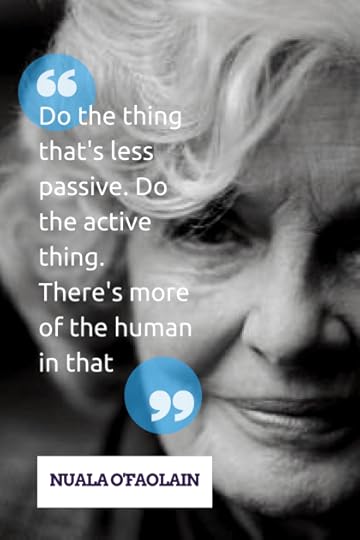
—————————————————————————————————————-
 This post is part of the Ireland Reading Month organised by 746 Books and The Fluff Is Raging blogs.
This post is part of the Ireland Reading Month organised by 746 Books and The Fluff Is Raging blogs.
“Last year we hosted a whopping 130 posts on all things relating to Irish culture. Books, food, travel, movies, theatre and favourite bookshops – your enthusiasm was boundless and so was your reading.
So this year we hope to be bigger and better.
To celebrate the wealth and breadth and general awesomeness of Irish cultural life, 746 Books and Raging Fluff are co-hosting a month long celebration of all things Irish.”
The post Human (Nuala O’Faolain) appeared first on The Old Shelter.
March 10, 2017
Gang Roundup – March 2017
Welcome to another gang roundup! Because of my two weeks without the laptop, I feard this roundup was going to be quite thin. Instead it turned out quite nice, don’t you think?

Dieselpunk Lexicon Part 10: Decopunk
Like Retrofuturism, Decopunk is a prolific subjenre of Dieselpunk, one that rests more firmly on the Art Deco aesthetics. Because it generally leans more on the earlier half of the Diesel Era (particularly the 1920s), it tends to be a little bit less dark than most Dieselpunk, which normally offers very strong noir elements.
This said, many people use Dieselpunk and Decopunk interchangeably.
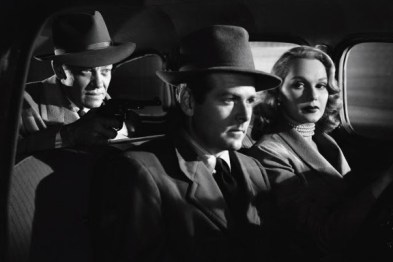 Noir City 2017 Highlights Heists and Favors Risk Over Genre Purity
Noir City 2017 Highlights Heists and Favors Risk Over Genre PurityAnd speaking about noir, the Noir City Film Festival has just taken place in Seattle, showcasing noir (and not so noir) film, this year with a particular focus on heist movies.
“You could say that the heist film is the original antihero team endeavor, the supervillain squad combining their unique skills to a common cause—in this case, the impossible robbery. This is one of those times when we root for the bad guys.
Most of the time, anyway.”
Here’s a nice lineup of classics. Have a look!
SS-GB
I was nearly done with the roundup today, when I stumbled upon this trailer. Oh my!!!
Base on the book SS-GB by Len Deighton, this is a five-part BBC tv series that looks great. It is set in an alternative Great Britan where the Battle of London had been lost and now the country is dominated by the Nazis. This is certainly not the only story with this premise, but by this trailer seems like the story concentrates on moral choices and taking sides, and I always like this kind of dilemmas. And the setting is just gorgeous. I’ll try to get my hands on this one, and maybe on the book too.
I wonder about the popularity of this theme (The Man in the High Castle by Philip K. dick has also been make into a series recently). I smell the anxiety of our times here…
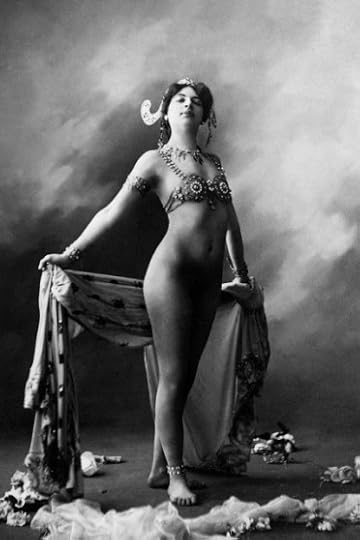
Mournful Fate of Mata Hari, and 14 Stunning Photos of This Dutch Exotic Dancer, Courtesan and Notorious WWI Spy from 1905-1917
Let’s face it, Mata Hari is probably one of the best known, more mysterious and controversial people of the XX century. She was the first to use truth and lie about her life, to the point that today discerning one from the other is very difficult. It was a dangerous game, whcih ultimately destoyed her. But she remains a romantic figure who still fascinates us after 100 years.
“The trial took place before a military tribunal, in secret. It lasted only two days. According to some accounts, the defense was not allowed to question any of the witnesses. The official French intelligence file on Mata Hari was sealed for 100 years, and won’t be released until 2017. According to some who have claimed to have seen it, there is no hard evidence cited in the dossier to establish that the dancer actually passed any military secrets to the Germans.
Mata Hari was executed by a French firing squad on the morning of October 15, 1917.”
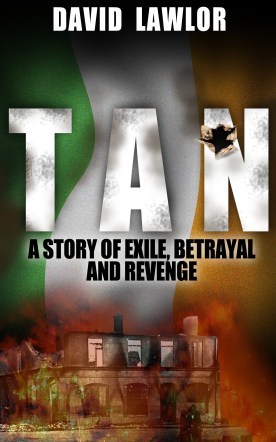
Tan by David Lawlor
It’s 1914 and Liam Mannion is forced into exile for a crime he didn’t commit. He flees Balbriggan, the only home he has ever known and travels to England, where he enlists and endures the torment of trench warfare in France. Five years later he’s back in England, a changed man, living in the shadow of his battlefield memories. Liam finds work in a Manchester cotton mill but prejudice and illness soon see him destitute. Starving and desperate, he enlists in a new military force heading to Ireland – the Black and Tans – and is posted to the very town he fled as a youth.
I’ve just started reading this and am really enjoying it, so expect to hear of it soon.
Das historische Berlin
My sister sent me this clip from 1920s Berlin. I love vintage futage and this is no exception. I get the impression of a very modern, very busy city, which certainly Berlin was int he 1920s.
Berlin 1920s
This is a presentation od Weimar Berlins 1920s, a section of the univers of Second Life.
Second Life is an online RPG, or I should say, a virtual reality where players can interact and create. Unlike most RPG, Second Life doesn’t have a set goal to reach, there’s no pre-made adventure to be unfold, but rather residents (as the players are called) freely goe around the reality they choose to be in (there are many different once) and create their second life by meeting other residents and creating their own plans.
Weimar Berlin looks pretty fascinating, don’t you think?

The post Gang Roundup – March 2017 appeared first on The Old Shelter.
March 4, 2017
Give in to the Feeling First Bookversary
Hi everyone! Sorry I’ve been absent for so long. Truth be told, my laptop had a problem and I was without it for nearly twenty days. Yeah, I had my mobile and I tried to stay in touch through that… but let me tell you I just can’t do that. It drove me crazy.
But I’m back and just in time for – guess what! – Give in to the Feeling first bookversary!!!!!!
Can you imagine it’s already a year since my baby went into the world? It’s been a rollercoaster of a year (and not just because of the book…), it was exciting at times and – I won’t hide it – very disappointing at others, but I still want to celebrate this little milestone with you. So, just for today, grab Give in to the Feeling for FREE. And when you read it, just spare two minutes for me and let me know what you thought about it. Really anything, good and bad, I’d love to hear it. And if you feel like writing a review, you’ll make me one happy author.
You know? I think I’d should do something to celebrate by bookversary, something that will smell fresh and new. So, since I truly hate my current blurb, why not write a new one? Maybe because I suck at writing them? Well… you have a point. But maybe you fell like giving me an hand at this? I’d appreciate your opinion on this, really I would.
Here’s my new blurb (well, my working new blurb). What do you think?
GIVE IN TO THE FEELINGChicago 1924
When Susie arrived from China two years ago, her life unexpectedly changed radically. Simon gave her everything she once barely dared to dream of: a lush carefree life, the New Woman’s freedom to dance, dress daringly and behave as she pleases.
Susie never imagined she would one day want even more, until one night she meets Blood in Simon’s speakeasy and he offers her a dance and his value for her feelings and thoughts.But she’s still Simon’s woman and he won’t allow her to forget it.
As she fights off her love for Blood, Susie realises the life Simon has given her is just an illusion, but it’s still everything she has and she owns it to him. In the clash between the two men’s personalities, the veil of reality falls and Susie can see right into the spirit world, where not just her heart, but her very soul is at stack. Then she has to choose whether what she really wants is Simon’s safe comfortable golden cage or Blood’s unknown intangible freedom.
I’m undecided about the second half most of all. I can’t decide whether I want to include a reference to the speculative nature of the story or not. On the one hand, I think it’s fair that the reader knows there is a speculative twist, because many readers would gladly read a historical novel, but not a fantasy one. But on the other hand, hard as I try, I can’t seem to be able to include that aspect of the story and not make a mess of the blurb.
Tell, me, tell me everything you think!
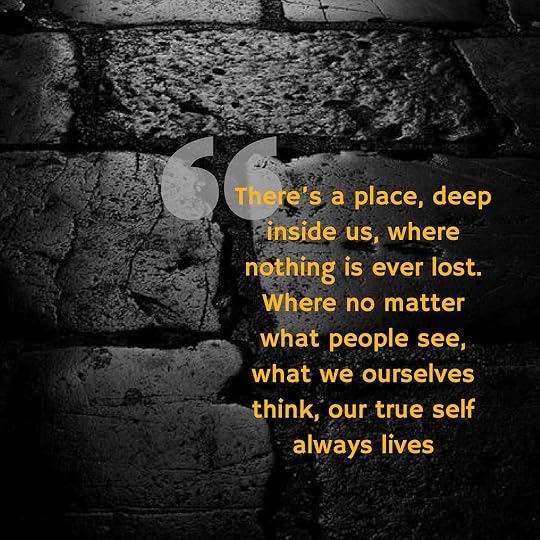
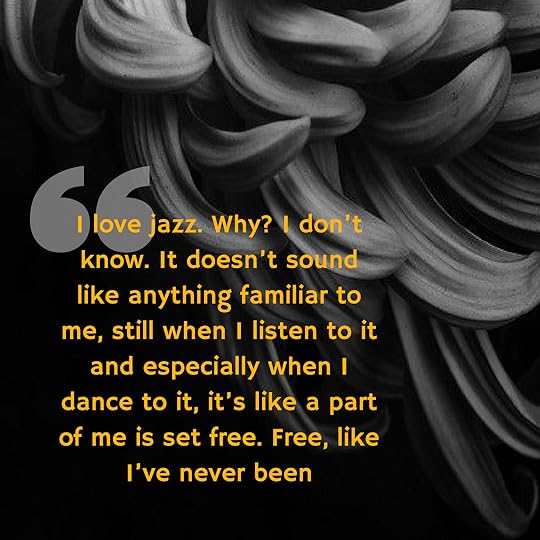
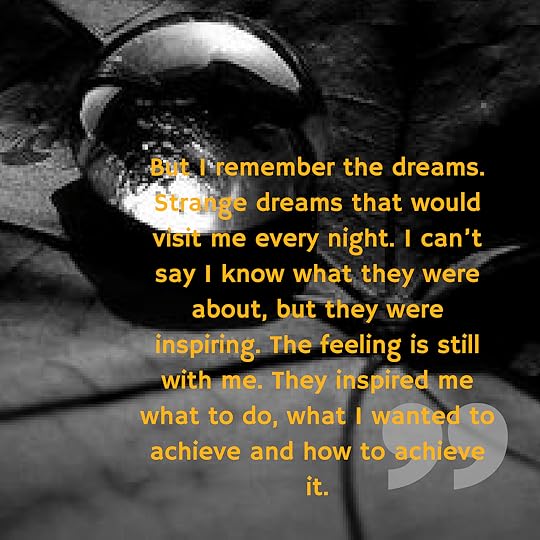
If you fancy to get the book, here’s where you’ll find it. Once again, Give in to the Feeling isn’t on Amazon, but Kindle reader can still get a .mobi file via Smashwords
Smashwords | Barnes&Nobles | Kobo | iBookStore
And many other stores
And here is my Pinterest board, where in addition to the blog tour pins, you’ll find pins to a few book reviews too
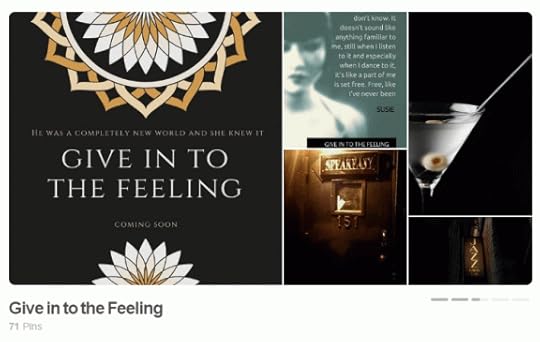
Hope you’ll have a go at my story
The post Give in to the Feeling First Bookversary appeared first on The Old Shelter.



